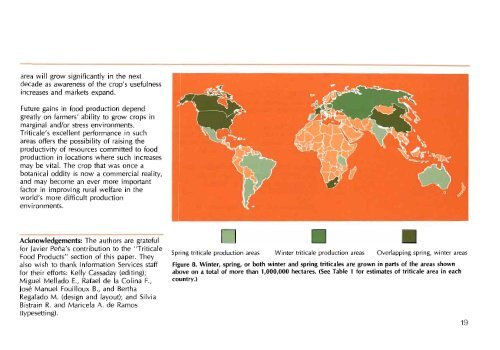U - Search CIMMYT repository
U - Search CIMMYT repository
U - Search CIMMYT repository
Create successful ePaper yourself
Turn your PDF publications into a flip-book with our unique Google optimized e-Paper software.
area will grow significantly in the next<br />
decade as awareness of the crop's usefulness<br />
increases and markets expand.<br />
Future gains in food production depend<br />
greatly on farmers' ability to grow crops in<br />
marginal and/or stress environments.<br />
Triticale's excellent performance in such<br />
areas offers the possibility of raising the<br />
productivity of resources committed to food<br />
production in locations where such increases<br />
may be vital. The crop that was once a<br />
botanical oddity is now a commercial reality,<br />
and may become an ever more important<br />
factor in improving rural welfare in the<br />
world's more difficult production<br />
environments.<br />
Acknowledgements: The authors are grateful<br />
for Javier Pena's contribution to the "Triticale<br />
Food Products" section of this paper. They<br />
also wish to thank Information Services staff<br />
for their efforts: Kelly Cassaday (editing);<br />
Miguel Mellado E., Rafael de la Colina F.,<br />
Jose Manuel Fouilloux B., and Bertha<br />
Regalado M. (design and layout); and Silvia<br />
Bistrain R. and Maricela A. de Ramos<br />
(typesetti ng).<br />
D<br />
Spring triticale production areas Winter triticale production areas Overlapping spring, winter areas<br />
Figure 8. Winter, spring, or both winter and spring triticales are grown in parts of the areas shown<br />
above on a total of more than 1,000,000 hectares. (See Table 1 for estimates of triticale area in each<br />
country.)<br />
19

















